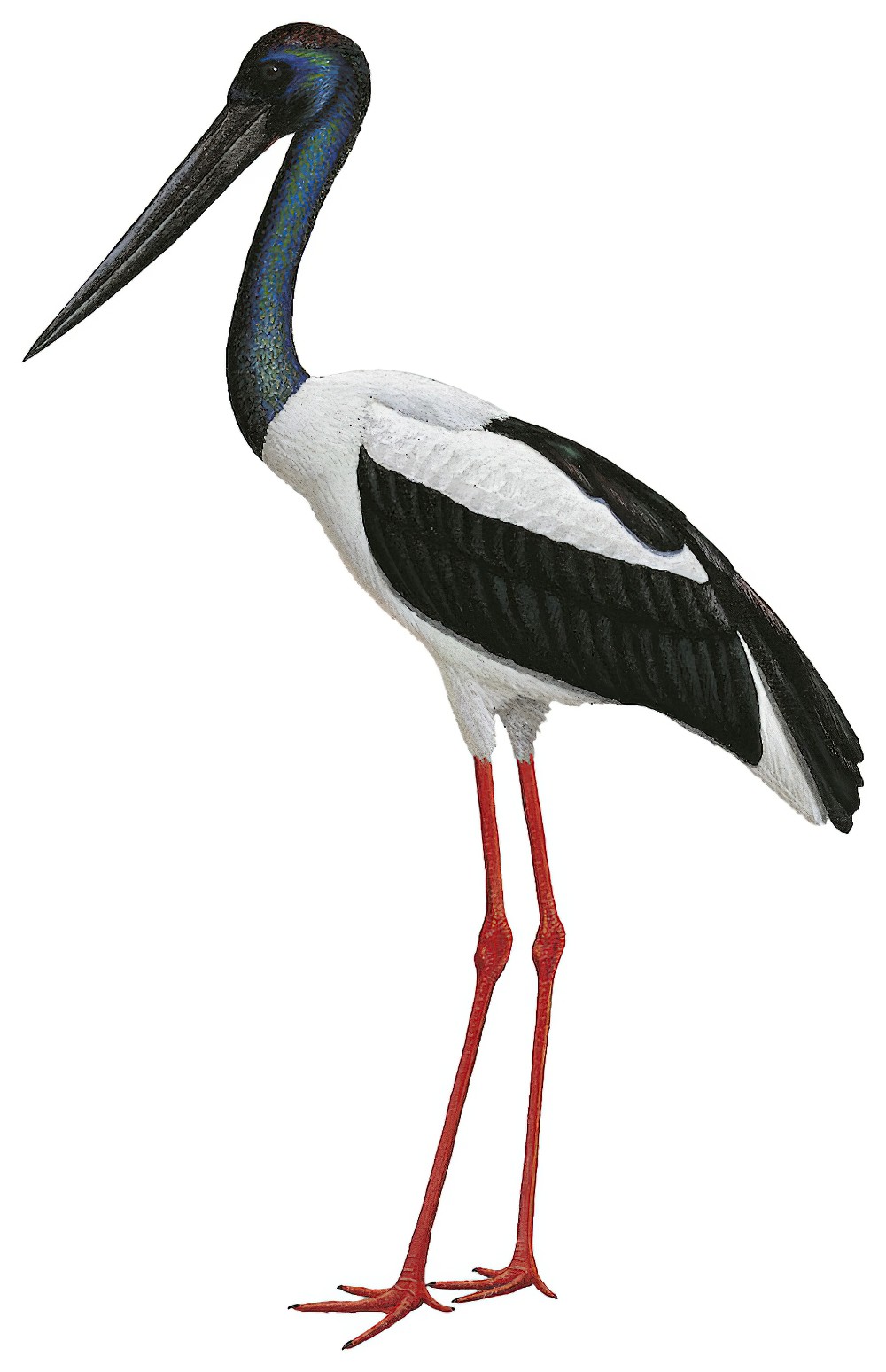Black-necked Stork / Ephippiorhynchus asiaticus

Black-necked Stork
SCI Name:
Protonym: Mycteria asiatica IndexOrn. 2 p.670
Taxonomy: Ciconiiformes / Ciconiidae / Ephippiorhynchus
Taxonomy Code: blnsto1
Type Locality: India.
Author: Latham
Publish Year: 1790
IUCN Status: Near Threatened
DEFINITIONS
EPHIPPIORHYNCHUS
(Ciconiidae; Ϯ Saddle-billed Stork E. senegalensis) Gr. εφιππιος ephippios saddle < επι epi upon; ἱππος hippos horse; ῥυγχος rhunkhos bill (cf. specific name Ciconia ephippiorhyncha Temminck, 1824 (= syn. E. senegalensis)): "Bill long, slightly recurved, with distal half (ca 150 mm) deep red, middle third (ca 100 mm) black, and basal fifth (ca 60 mm) covered with deep red fleshy lappet, extending back to eye. Above red lappet is a bright yellow lappet (forming 'saddle'), edged with tiny black feathers." (Hockey et al. 2005); "*101. Ephippiorhynchus, Bp. (Mycteria, part. Gr.) Rostrum altum, magnum, gonyde perascendente; clypeo frontale membranaceo triangulare: regione periophthalmica nuda; lobulo carnoso, ad angulos oris hinc inde affixo: caput collumque plumosa. MYCTERIA senegalensis, Shaw. (Ciconia ephippiorhyncha, Temm. - C. senegalensis, Vieill.? - Ephippiorhynchus senegalensis, Bp.) Linn. Trans. v. p. 32. t. 3. caput. - Lath. Ind. Orn. Suppl. p. 64. - Pl. col. 64. - Vieill. Gal. Ois. t. 255. - Bowdich, Excurs. Mad. p. 229. - Rupp. Atl. t. 3. - Reich., Syst. Av. t. 166. f. 444. ex Senegal, Gambia, Abyssinia." (Bonaparte 1855); "Ephippiorhynchus Bonaparte, Consp. Av., 2, 1855, p. 106. Type, by monotypy, Mycteria senegalensis Shaw." (Peters, 1931, I, p. 130).
Var. Epphipiorhynchus, Epphiiorhynchus.
Synon. Xenorhynchopsis, Xenorhynchus.
ephippiorhynchus
Gr. εφιππιος ephippios saddle < επι epi upon; ἱππος hippos horse; ῥυγχος rhunkhos bill.
asiae / asiatica / asiaticus
L. Asiaticus Asiatic < Gr. Ασιατικος Asiatikos Asiatic < Ασια Asia. The Romans generally and indiscriminately applied the name Asia to Asia Minor (Turkey or Anatolia), the more extensive eastern and southern portions of the great continent being known as Asia Maior. In nomenclature the toponym is nearly synonymous with India.
● ex "Gaur Bunting" of Latham 1787 (?syn. Amandava x Lonchura).
● ex “Bombay Goatsucker” of Latham 1787 (Caprimulgus).
● Erroneous TL. Asia (= Africa) (syn. Caprimulgus pectoralis).
● ex “Purple Indian Creeper” of Edwards 1760, and “Yellow-winged Creeper” of Latham 1787 (Cinnyris).
● ex “Indian Jabiru” of Latham 1787 (Ephippiorhynchus).
● ex “Blue-cheeked Curucui” of Latham 1787 (Megalaima).
● Erroneous TL. The Indies (= Jamaica); ex “Brown Indian Dove” of Edwards 1751, and “Columba subfusca media” of Browne 1756 (Zenaida).
SUBSPECIES
Black-necked Stork (asiaticus)
SCI Name: Ephippiorhynchus asiaticus asiaticus
asiae / asiatica / asiaticus
L. Asiaticus Asiatic < Gr. Ασιατικος Asiatikos Asiatic < Ασια Asia. The Romans generally and indiscriminately applied the name Asia to Asia Minor (Turkey or Anatolia), the more extensive eastern and southern portions of the great continent being known as Asia Maior. In nomenclature the toponym is nearly synonymous with India.
● ex "Gaur Bunting" of Latham 1787 (?syn. Amandava x Lonchura).
● ex “Bombay Goatsucker” of Latham 1787 (Caprimulgus).
● Erroneous TL. Asia (= Africa) (syn. Caprimulgus pectoralis).
● ex “Purple Indian Creeper” of Edwards 1760, and “Yellow-winged Creeper” of Latham 1787 (Cinnyris).
● ex “Indian Jabiru” of Latham 1787 (Ephippiorhynchus).
● ex “Blue-cheeked Curucui” of Latham 1787 (Megalaima).
● Erroneous TL. The Indies (= Jamaica); ex “Brown Indian Dove” of Edwards 1751, and “Columba subfusca media” of Browne 1756 (Zenaida).
Black-necked Stork (australis)
SCI Name: Ephippiorhynchus asiaticus australis
australe / australis
L. australis southern < auster, austri south.
● Tierra del Fuego; ex “Thorn-tailed Warbler” of Latham 1783 (syn. Aphrastura spinicauda).
● Cayenne; ex “Southern Sandpiper” of Latham 1785 (?syn. Calidris canutus).
● Erroneous TL "Friendly Islands" (= Tasmania); ex "South-Sea Raven" of Latham 1781 (syn. Corvus coronoides).
● Erroneous TL. New Guinea (= Luzon, Philippines); ex “Manikor de la Nouvelle Guinée” of de Buffon 1770-1783 (Dicaeum).
● Australia; ex “New Holland Snipe” of Latham 1801 (syn. Gallinago hardwickii).
● Australia; ex “Pacific Paroquet (var.)” of Phillip 1789 (syn. Glossopsitta concinna).
● Australia; ex “New Holland Pelican” of Latham 1824 (syn. Pelecanus conspicillatus).
● Australia; ex “Cold-river Goatsucker” of Latham 1823 (syn. Podargus strigoides).
● Australia; ex “New Holland Quail” of Latham 1802 (Synoicus).
● Tasmania; ex Brown MS (syn. Lathamus discolor).
● Dusky Sound, New Zealand (syn. Nestor meridionalis).
● Staten I., off Tierra del Fuego (= Isla de los Estados, Argentina); ex “Statenland Eagle” of Latham 1781 (Phalcoboenus).
● Christmas I.; ex "Southern Tern" of Latham 1785 (syn. Procelsterna caerulea) (so identified by Stresemann 1950).
● Kerguelen I.; ex “Southern Tern” of Latham 1785 (?syn. Sterna vittata).
● Madagascar; ex “Palumbus viridis Madagascariensis” of Brisson 1760 (Treron).
● Erroneous TL. Sandwich Is. (= Samoa); ex “Blue-crested Parrakeet” of Latham 1781 (Vini).
● Tierra del Fuego; ex “Rusty-collared Finch” of Latham 1783 (subsp. Zonotrichia capensis).
UPPERCASE: current genus
Uppercase first letter: generic synonym
● and ● See: generic homonyms
lowercase: species and subspecies
●: early names, variants, mispellings
‡: extinct
†: type species
Gr.: ancient Greek
L.: Latin
<: derived from
syn: synonym of
/: separates historical and modern geographic names
ex: based on
TL: type locality
OD: original diagnosis (genus) or original description (species)












